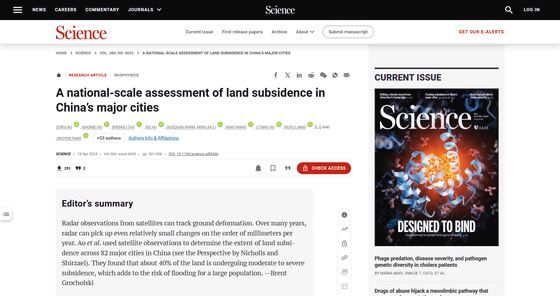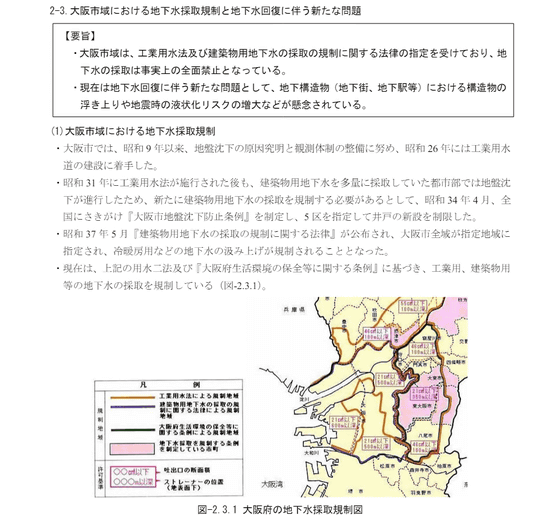Survey finds most Chinese cities sinking, experts say Tokyo and Osaka should follow suit

A study by Professor Robert Nichols of the Tyndall Centre for Climate Change Research at the University of East Anglia and Professor Manouchehr Shirzaei of Virginia Tech has found that nearly half of China's major cities are sinking due to groundwater pumping and the weight of urban buildings and infrastructure.
A national-scale assessment of land subsidence in China's major cities | Science

China's third urban population at risk of city sinking, new satellite data shows | UEA
https://www.uea.ac.uk/about/news/article/a-third-of-chinas-urban-population-at-risk-of-city-sinking-new-satellite-data-shows
The study analyzed 82 Chinese cities with a total population of approximately 700 million. It found that 45% of the analyzed urban areas are experiencing land subsidence, with 16% experiencing land subsidence at a rate of more than 10mm per year. Across China, it is estimated that approximately 270 million urban residents are affected, of which approximately 70 million are experiencing rapid land subsidence of more than 10mm per year.

According to the research team, the main cause of land subsidence in China is human-induced, especially excessive pumping of groundwater, which is thought to be a major factor, causing the groundwater level to fall.
Geological conditions and the weight of buildings also seem to affect land subsidence. In Beijing, land subsidence of up to 45 mm per year has been observed near subways and expressways, so traffic vibrations and tunnel excavation may also be contributing factors locally.
In the United States, New Orleans suffered severe damage from
In addition, Shanghai, China's largest city, has sunk by up to 3 meters over the past 100 years and continues to sink. The combination of land subsidence and sea level rise could triple China's urban areas by 2120, affecting 55 to 128 million residents, the research team points out, arguing that without a strong social response, it would have devastating consequences.

The research team cites Tokyo and Osaka in Japan as examples where land subsidence has become a social problem.
In Tokyo, groundwater was pumped in large quantities for industrial and drinking water from the 1920s to the 1970s, causing land subsidence of up to 4.5 meters. The eastern lowlands of Tokyo were particularly affected. However, as in Osaka, restrictions on pumping groundwater were introduced in the 1970s, and land subsidence has been greatly reduced. At the time of writing, groundwater management and land subsidence monitoring are ongoing in Tokyo.
'Groundwater and Land Subsidence Verification Report' and 'Tokyo Groundwater and Ground Environment Report' | Sustainable Groundwater Conservation and Use | Tokyo Metropolitan Government Bureau of Environment
https://www.kankyo.metro.tokyo.lg.jp/water/chikasuinohozentoriyo/report

In Osaka, excessive pumping of groundwater from the 1930s to the 1960s caused land subsidence of up to 2.5 meters. This increased the risk of flooding and caused serious damage to buildings and infrastructure. However, restrictions on pumping groundwater were introduced in the 1960s, and by the 1970s pumping of groundwater was completely banned, and land subsidence had almost halted. Currently, some areas are gradually rising as groundwater recovers.
2-3. New problems associated with groundwater extraction restrictions and groundwater recovery in the Osaka area
(PDF file) https://www.city.osaka.lg.jp/kankyo/cmsfiles/contents/0000476/476996/houkokusyo2(10-17).pdf

Based on the examples of Tokyo and Osaka in Japan, the research team states that regulating groundwater pumping is an effective measure to mitigate land subsidence, and recommends that sustainable groundwater management and urban development be promoted in other countries, including China.
The team also called for collaboration with urban planners and policy makers to better understand the impacts of land subsidence and to develop appropriate countermeasures, stressing that land subsidence is a more widespread problem than recognized and requires a national response.
Related Posts:
in Note, Posted by log1i_yk







